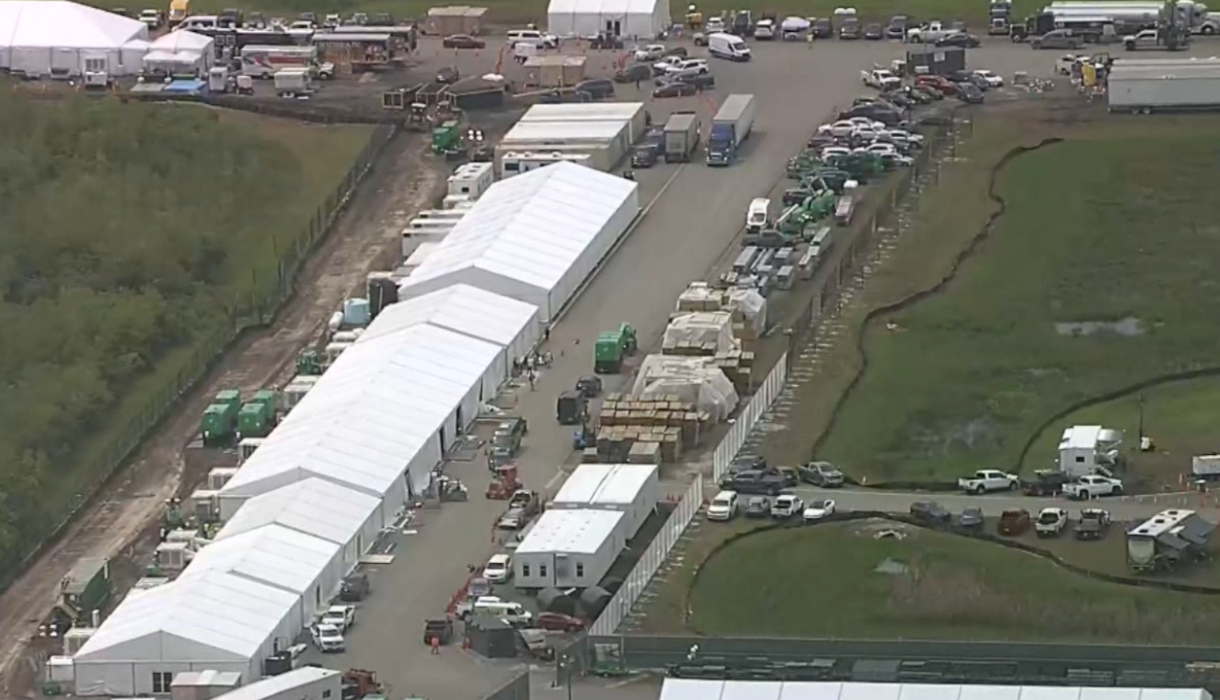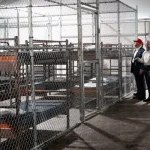
Inside Alligator Alcatraz: Florida’s Immigration Detention in the Shadow of the Everglades.
Posted in :
Florida’s “Alligator Alcatraz” detention center exposes a brutal clash between immigration policy, human rights, and Everglades conservation—where detainees suffer in tents while politicians cash in.
A firsthand look at Alligator Alcatraz, Florida’s controversial immigration detention center situated in the heart of the Everglades. Exploring personal accounts, environmental controversies, political showmanship, and the inconvenient truths behind the headlines.
I never imagined an immigration story could involve alligators, hurricanes, and alleged government waste—but standing on the edge of the Everglades, the rumors about ‘Alligator Alcatraz’ stop feeling like urban legend and start sounding dangerously real. Not long ago, I caught a whiff (literally and figuratively) of something off as I tried to piece together what’s really happening behind the wire. This blog is part confession, part investigation, and definitely not what I expected from Florida’s latest immigration scheme.
Muggy Mornings in the Everglades: Life and Loss at Alligator Alcatraz
Let me just say it: the stories coming out of the Alligator Alcatraz detention center are wild—and not in a good way. This place, dropped right in the heart of the Everglades, is already infamous for its brutal detainee living conditions. I’ve spent hours digging into firsthand detainee testimonials, lawmakers’ tours, and reports from advocates. What I found is a mess of contradictions, suffering, and a whole lot of heat—literally and figuratively.
Firsthand Accounts: “It’s Like a Hell Hole”
So, what’s it really like inside Alligator Alcatraz? According to people actually living there, it’s rough. One detainee, Leanso, described going four days without a shower. He said there are about 400 people crammed inside, most of them with no criminal records. Food? Once a day, and sometimes it’s barely warm. Water? Not enough to go around. The lights are on 24/7, making it impossible to sleep properly. And the mosquitoes? Leanso joked they’re “the size of elephants,” but honestly, it doesn’t sound like much of an exaggeration.
Here’s the kicker: these aren’t just hardened criminals. Many are people who were picked up for things like driving without a license or minor immigration violations. Some were even planning to self-deport but got swept up anyway. Their families are left outside, desperate for news, while inside, detainees are stuck in cages, beds lined up under glaring lights, begging for “libertad.”
Heat, Bugs, and Barely Any Showers
Let’s talk about the physical detention center conditions. The tents are supposed to be “air-conditioned,” but when Congresswoman Debbie Wasserman Schultz visited, she brought her own thermometer. It read 83°F at the entrance of a tent, and 85°F in the medical intake area. That’s not just uncomfortable—it’s dangerous, especially for people stuck inside all day. And then there’s the bug problem. Grasshoppers and mosquitoes swarm everywhere, even on the mattresses. Imagine trying to sleep with that.
Showers are a rare luxury. Some detainees go days without bathing. Water access is limited, and food is served just once a day. Overcrowding is a constant issue, with hundreds packed into flimsy tents that, let’s be real, probably wouldn’t survive a hurricane. And this is Florida, in the middle of hurricane season. It’s not just uncomfortable—it’s risky.
Lawmakers’ Tours: A Tale of Two Realities
Here’s where things get really weird. When lawmakers tour Alligator Alcatraz, their descriptions couldn’t be more different. Republicans come out saying it’s like a hotel—clean, air-conditioned, even “beautiful.” Democrats, on the other hand, call it a “hell hole.” Wasserman Schultz, who toured with other Democrats, said:
“Anyone who could have left that, by the way, completely scrubbed, sanitized, and pre-planned quote unquote tour… just kept us at threshold.”
She explained that they weren’t allowed to see the medical area, the cages where detainees actually live, or anything that wasn’t carefully staged. “They just kept us at threshold,” she said. That’s a huge red flag for transparency. Research shows that when lawmakers’ access is restricted, it’s usually because there’s something to hide.
Why So Harsh?
It’s hard not to wonder if these detainee living conditions are intentionally bad. The facility is way out in the Everglades—an hour and a half from anywhere, surrounded by swamp, bugs, and storms. Everything has to be trucked in, which drives up costs (reportedly $450 million a year) and makes daily life even harder for detainees. The tents are flimsy, and flooding is common. Advocates and even some lawmakers believe the harshness is by design, maybe to push people to self-deport.
Environmental groups and the Miccosukee Tribe are furious, too. The center sits on sacred land and threatens the Everglades ecosystem. Lawsuits are flying, but for now, operations continue, and hundreds remain trapped inside.
Unfiltered Reality: Beds in Cages, Pleas for Freedom
At the end of the day, the Alligator Alcatraz detention center is a place where people—most without criminal records—are caged, hot, hungry, and desperate. The official tours and press releases can’t hide the reality that’s leaking out through phone calls, family members, and the rare honest lawmaker. The pleas for “libertad” echo through the Everglades, but for now, they’re met with silence and the relentless buzz of mosquitoes.
The Everglades on the Edge: Environmental Fallout and Tribal Outrage
When you hear “Alligator Alcatraz,” it’s hard not to picture something out of a dystopian movie. But this is real—Florida’s newest immigration detention facility, plopped right in the heart of the Everglades, west of Miami, and operational since July 3, 2025. The state’s pitch? The Big Cypress National Preserve offers a “natural perimeter”—as if the swamp itself would keep people in. But the reality is way messier, and honestly, a lot more alarming.
Fast-Tracked and Furious: Skipping Environmental Review
Governor DeSantis didn’t just greenlight this project—he basically floored it. By declaring a 2023 state of emergency, the facility’s approval skipped over the usual environmental and procurement reviews. No time for public comment, no time for environmental impact studies, and definitely no time for tribal consultation. It was all about speed, not stewardship.
And that’s where the legal firestorm started. Environmental groups, led by Friends of the Everglades and the Center for Biological Diversity, immediately filed lawsuits to halt the project. The Miccosukee Tribe, whose sacred lands are now home to this massive compound, joined the legal fight. As Congresswoman Debbie Wasserman Schultz put it:
“They are not only infringing on sacred tribal lands where there was no consultation and now the Miccosukee tribe has joined the lawsuit.”
Miccosukee Tribe Opposition: “Stolen Sacred Land”
Let’s be real—this isn’t just about environmental lawsuits filed by passionate activists. The Miccosukee Tribe’s opposition is deeply personal. The land under the detention center isn’t just any patch of swamp; it’s sacred, with cultural and spiritual significance that can’t be measured in dollars or acres. The fact that tribal consultation was skipped entirely? That’s not just disrespectful—it’s a violation of established protocols and, arguably, federal law.
The tribe’s frustration is palpable. They’ve joined the lawsuits, demanding an injunction to stop operations. Their message is clear: this is stolen land, and the state’s disregard for tribal sovereignty is unacceptable.
Environmental Fallout: Wastewater, Wildlife, and Traffic Woes
So what’s the Everglades environmental impact? Experts and local news outlets aren’t mincing words. Research shows the facility’s presence is already causing collateral damage:
- Wastewater spills: With up to 5,000 detainees and no existing infrastructure, the risk of wastewater contamination is sky-high. The Everglades is a delicate ecosystem—one spill could have devastating ripple effects.
- Threatened species: Habitat loss and increased human activity threaten endangered species that call the Big Cypress National Preserve home. Mosquitoes and grasshoppers aren’t the only wildlife affected; the whole food chain is at risk.
- Traffic headaches: Every supply, every staff member, every visitor—everything has to be trucked in. That means more traffic, more pollution, and more stress on already fragile wetlands.
- Flood risk: The facility sits in a flood-prone area, and with Florida’s summer storms, flooding isn’t just a possibility—it’s a guarantee. Lawmakers touring the site saw standing water and evidence of recent floods.
Governor DeSantis claims there’s “zero impact,” but that’s just not what the data or the on-the-ground reality shows. Politifact and other outlets have called that claim flat-out false.
Legal Showdown: Friends of the Everglades v. Florida
The lawsuits aren’t just symbolic. Friends of the Everglades, the Center for Biological Diversity, and the Miccosukee Tribe are seeking a court-ordered injunction to halt operations. Their arguments? The state violated environmental review laws, ignored tribal rights, and put the Everglades ecosystem in jeopardy. The legal context here is huge—if the courts side with the plaintiffs, it could set a precedent for how (and whether) future projects can bypass environmental and tribal consultation requirements.
Financial Outrage: Double the National Cost
And then there’s the money. The facility costs Florida taxpayers a jaw-dropping $450 million a year—double the national average per detainee. Why? Because every single thing—food, water, medical supplies—has to be hauled in. There’s no infrastructure, and the structures themselves are basically tents, vulnerable to hurricanes and daily downpours. It’s a monument to waste, fraud, and abuse, as critics say, and it’s all happening on sacred, environmentally sensitive land.
Bottom line: The Everglades environmental impact is real, the Miccosukee Tribe opposition is fierce, and with environmental lawsuits filed and Friends of the Everglades v. Florida in motion, this story is far from over.
Politics, Promises, and Hurricane Paranoia: What (and Who) Built This Mess?
Let’s be real: if you’d told me a few years ago that Florida would end up with a $450 million-a-year immigration detention center in the middle of the Everglades—one that politicians would brag about while people inside sweat through hurricane season in tents—I’d have said you were dreaming. But here we are, and “Alligator Alcatraz” is no fever dream. It’s the messy, expensive, and frankly dangerous reality of Trump immigration policies and the DeSantis immigration emergency, all wrapped up in a shiny PR package and sold to the public as tough-on-crime, tough-on-borders, and “good for Florida.”
The grand opening was a spectacle. Trump, flanked by Homeland Security Secretary Kristi Noem and a parade of GOP allies, compared the place to Alcatraz—like that’s supposed to be reassuring. The message was clear: Florida immigration policies are about deterrence, not compassion. The facility was fast-tracked under a 2023 state of emergency declaration, skipping the usual environmental and procurement reviews. That’s how you end up with a sprawling tent city, plopped right in hurricane alley, with only one road in or out. I mean, who thought this was a good idea during hurricane season? Even before the first big storm, flooding was already an issue. The tents? Flimsy. The evacuation plan? Basically, cross your fingers and hope for the best.
And let’s talk about the money. This place is burning through $450 million a year—twice the national per capita cost for detention. Every single thing, from food to water to medical supplies, has to be trucked in. That’s not just inefficient; it’s a logistical nightmare. And if you’re wondering where all that cash is going, well, there are plenty of allegations that DeSantis cronies are getting rich off contracts. As Congresswoman Debbie Wasserman Schultz put it,
“This is a monument to waste, fraud, and abuse… It’s costing $450 million annually to house these detainees out in the middle of the Everglades.”
But the real cost isn’t just financial. It’s human. The “Dignity Act” and all those promises about only targeting “criminals” for deportation? Turns out, a lot of people locked up in Alligator Alcatraz have no criminal record at all. Some were picked up for things as minor as driving without a license. Families are being separated. People who were planning to self-deport—literally trying to follow the rules—are now stuck in cages, sometimes with just one meal a day, no showers, and 24/7 lights. State lawmakers visit and come away with wildly different stories. Some Republicans call it “amazing,” like a hotel. Democrats, meanwhile, describe bug-infested tents, stifling heat, and mattresses covered in mosquitoes. The truth? It’s not hard to guess which version lines up with what detainees and their families are saying.
There’s also the environmental mess. The site sits on land the Miccosukee Tribe considers sacred, and environmental groups are suing over the damage to endangered species and the risk of wastewater spills. DeSantis claims there’s “zero impact” on the Everglades, but experts and local news reports say otherwise. More traffic, habitat loss, and daily rainstorms that turn the place into a swamp—none of that sounds like “zero impact” to me.
So how did we get here? Political theater, mostly. Trump and his allies promised to crack down on “bad guys,” but the net is catching families, workers, and people with deep roots in the community. The Dignity Act gets headlines, but in real life, dignity is in short supply. Emergency funds meant for disaster relief are being funneled into a detention center that’s one big hurricane away from catastrophe. Accountability? Still missing in action.
At the end of the day, Alligator Alcatraz is a case study in what happens when politics, promises, and paranoia collide—leaving real people in the crosshairs. As hurricane season barrels on, the risks are only growing, and the consequences of these Florida immigration policies are playing out in real time, right in the shadow of the Everglades.
TL;DR: Alligator Alcatraz isn’t just another detention center—it’s a symbol of troubled immigration policies, questionable politics, and the clash between human rights and environmental responsibility at Florida’s wild edge.
AlligatorAlcatrazWikipedia, FloridaImmigrationCenter, DetentionFacilityEverglades, ImmigrantDetentionFlorida, TrumpImmigrationPolicies, DetaineeLivingConditions, EvergladesEnvironmentalImpact, MiccosukeeTribeOpposition, HurricaneSeasonRisks, DeSantisImmigrationEmergency,Floridaimmigrationpolicy2025, Evergladesdetentioncentercrisis, MiccosukeeTribelandrights, DeSantisimmigrationemergency, $450milliondetentionscandal
#AlligatorAlcatraz, #FloridaDetention, #ImmigrationReform, #EvergladesImpact, #TribalRights, #MigrantJustice, #EnvironmentalJustice, #ICEFlorida, #DetaineeVoices, #StopTheAbuse,#AlligatorAlcatraz, #FloridaImmigration, #DeSantis, #DetentionCrisis, #EnvironmentalJustice, #HumanRights, #MiccosukeeTribe, #Everglades, #ICE, #DignityAct

